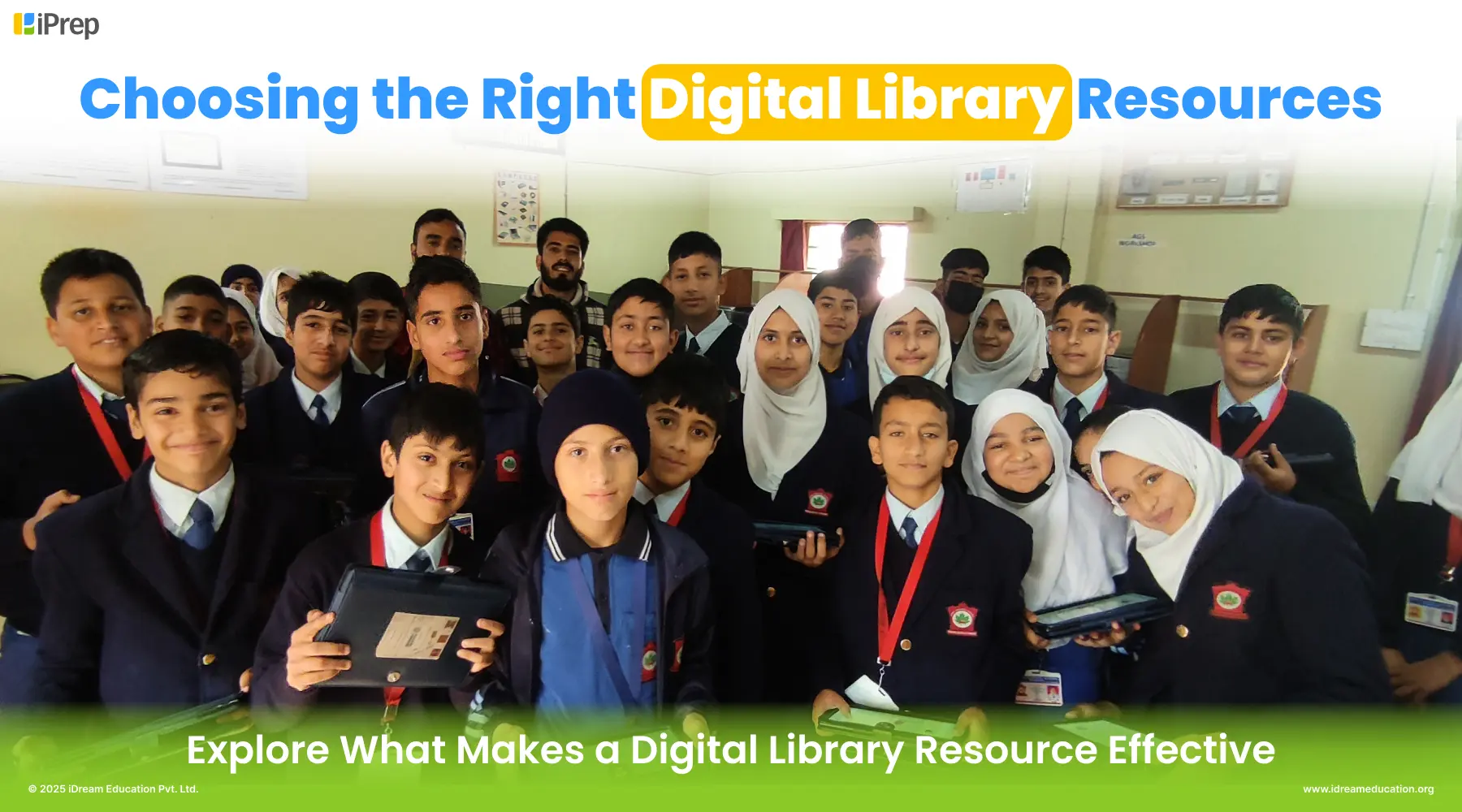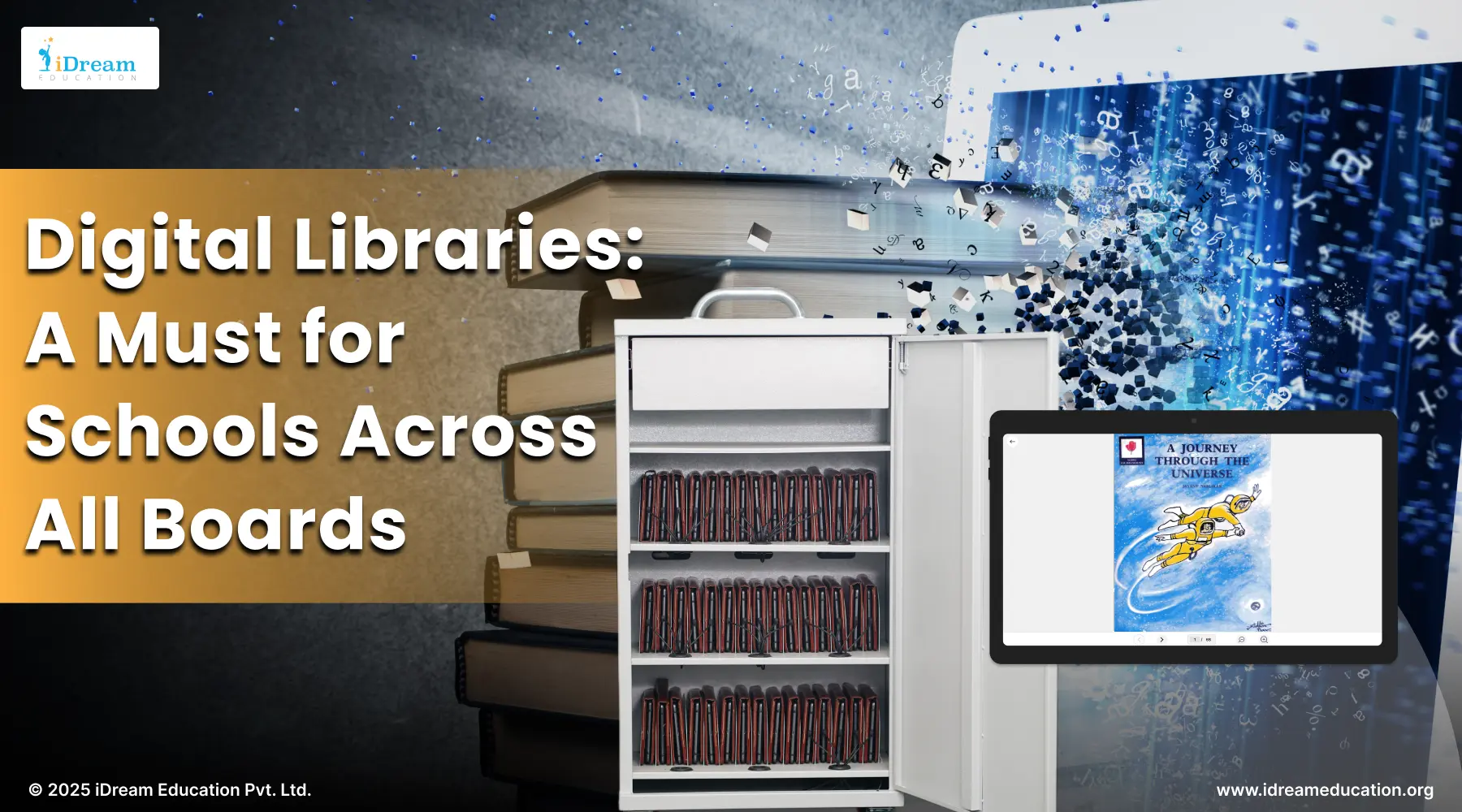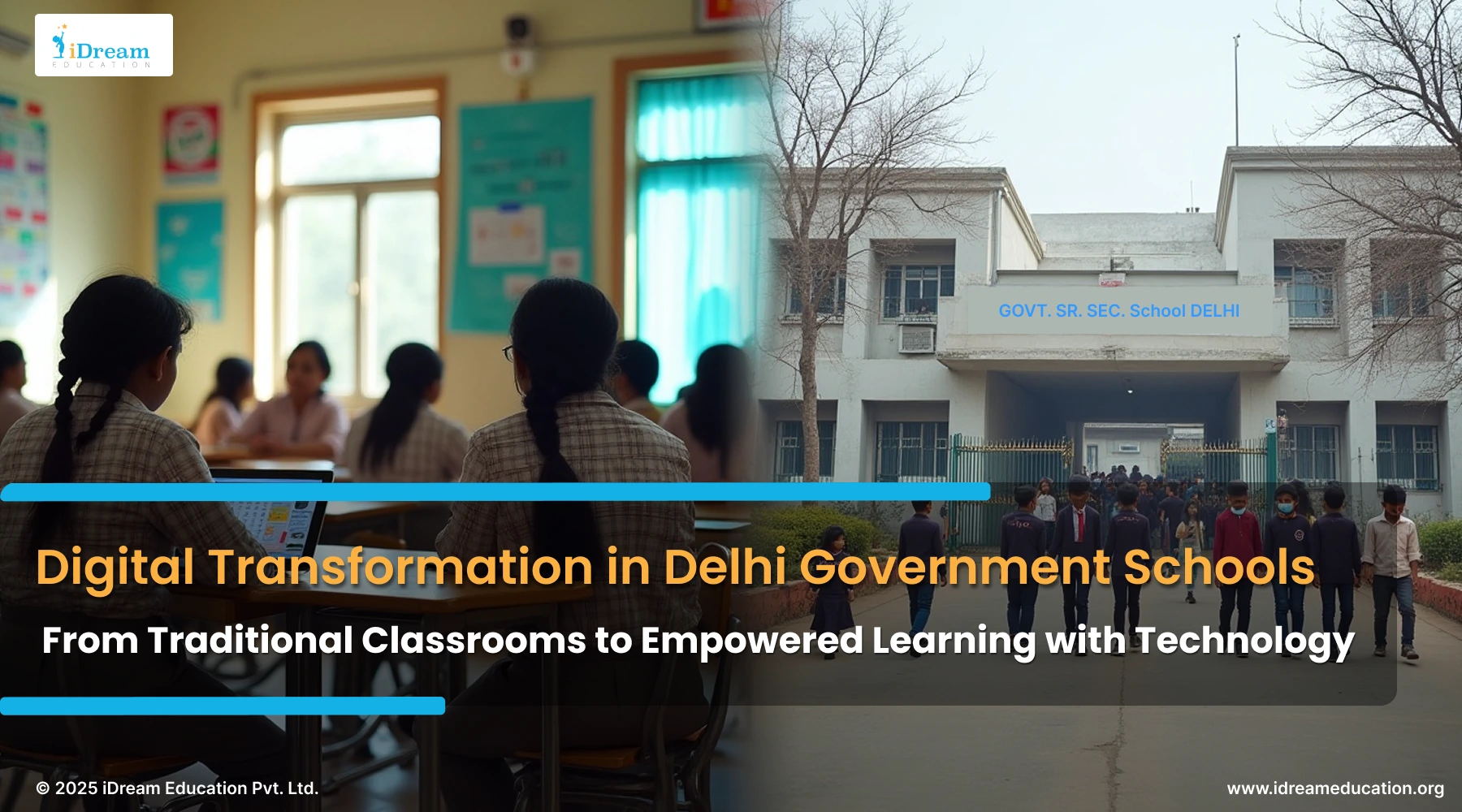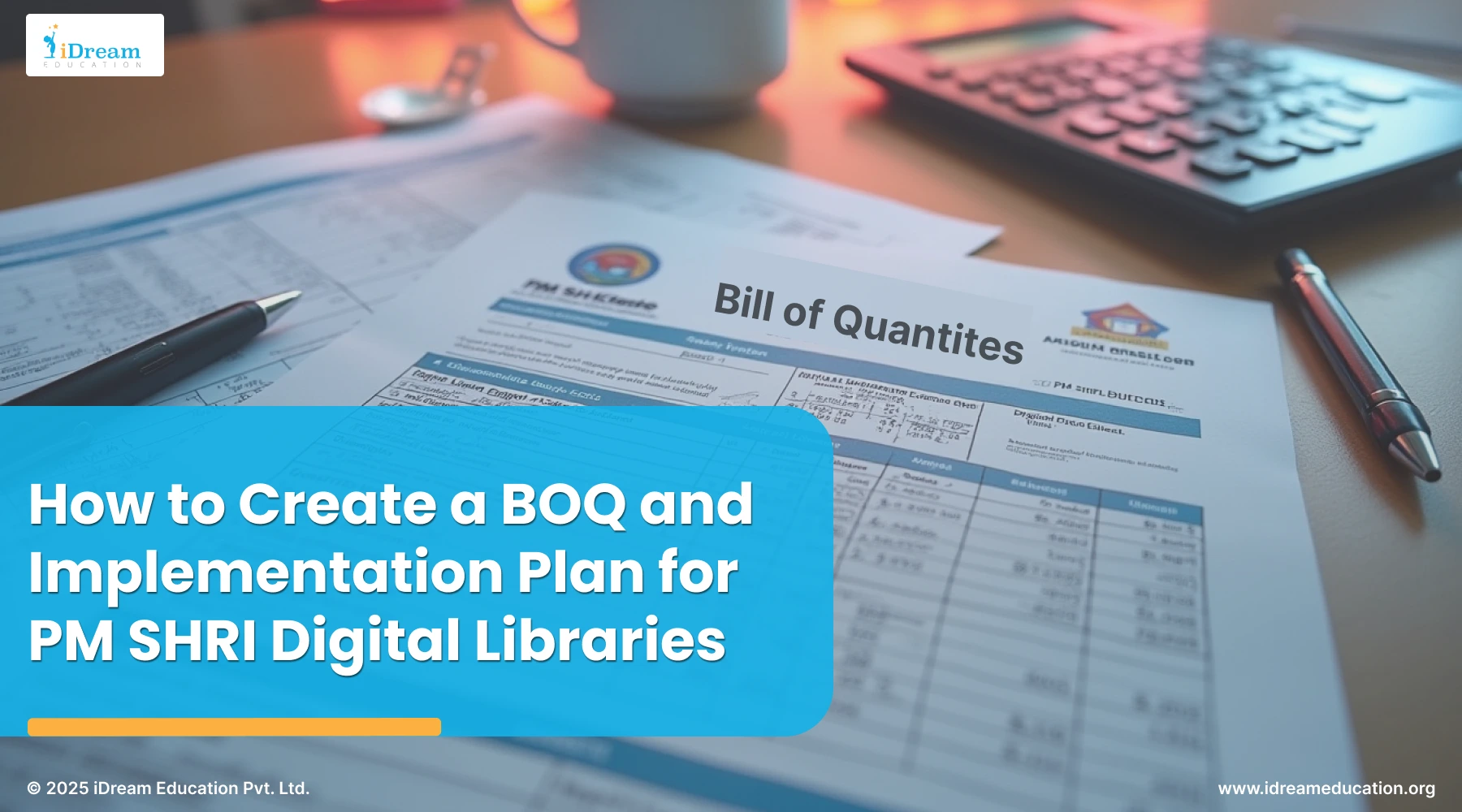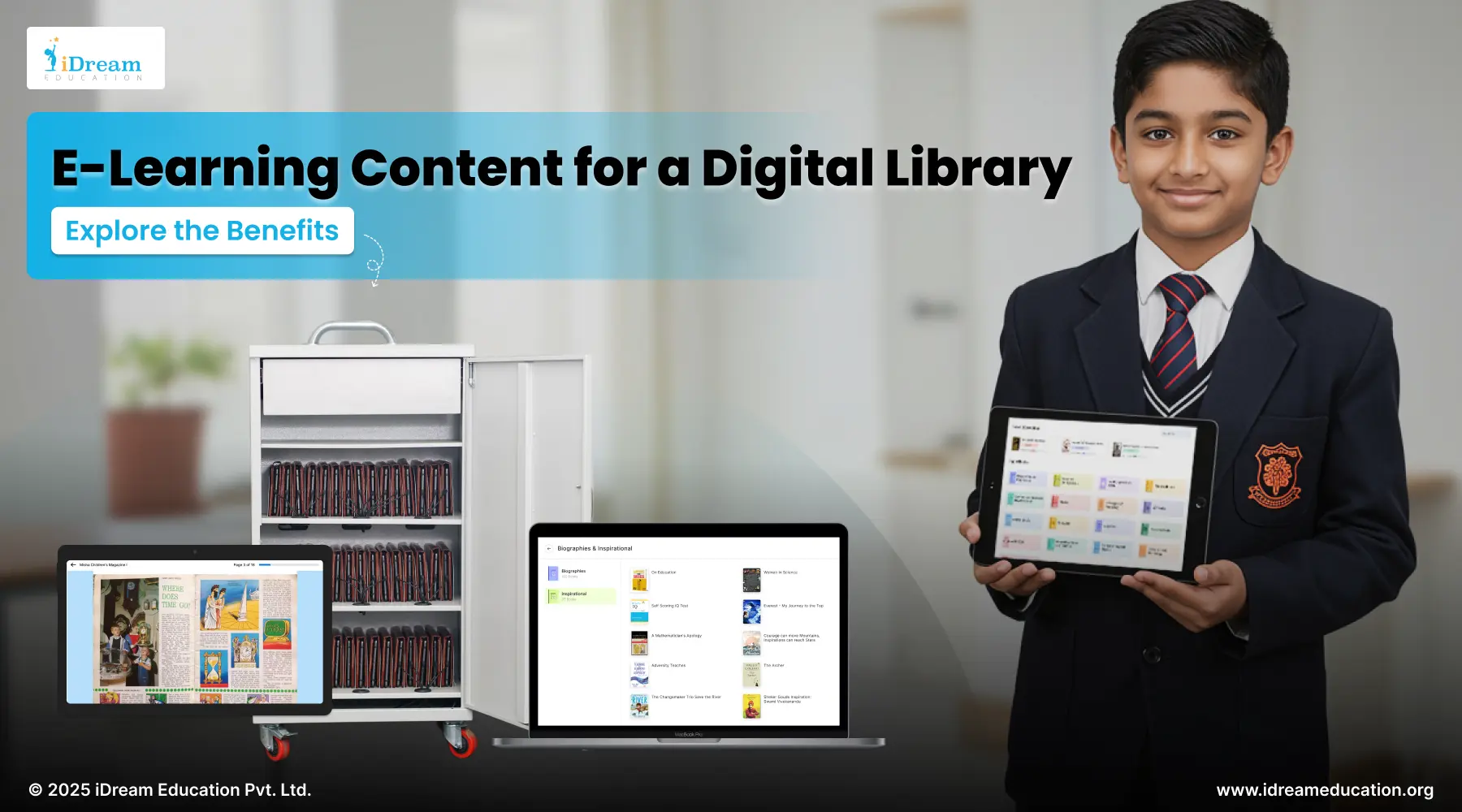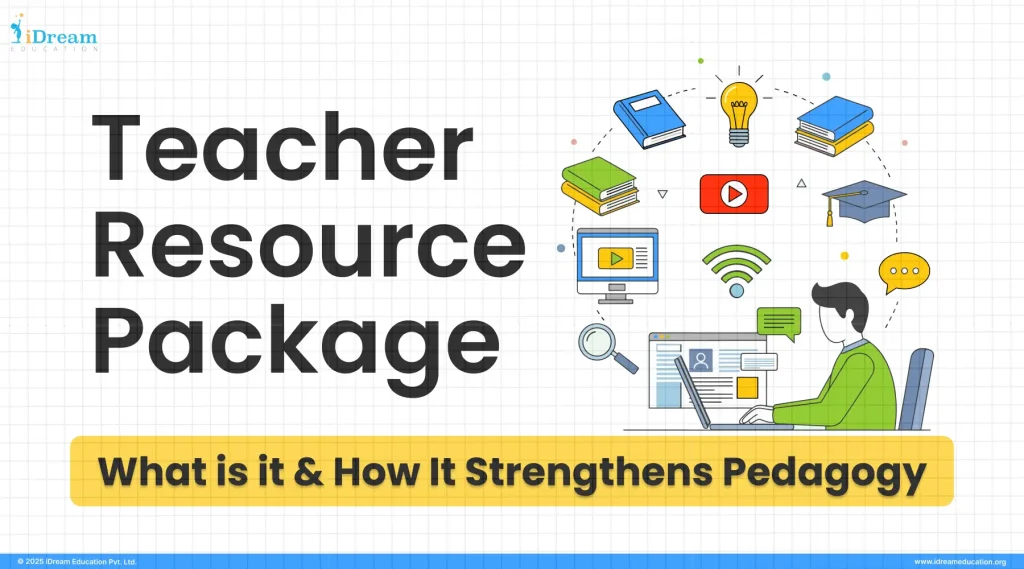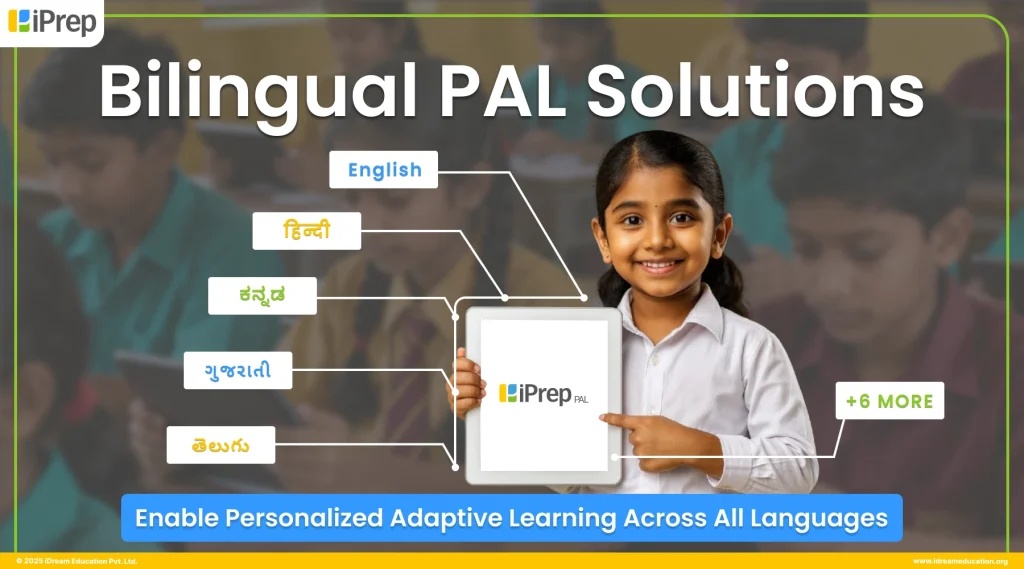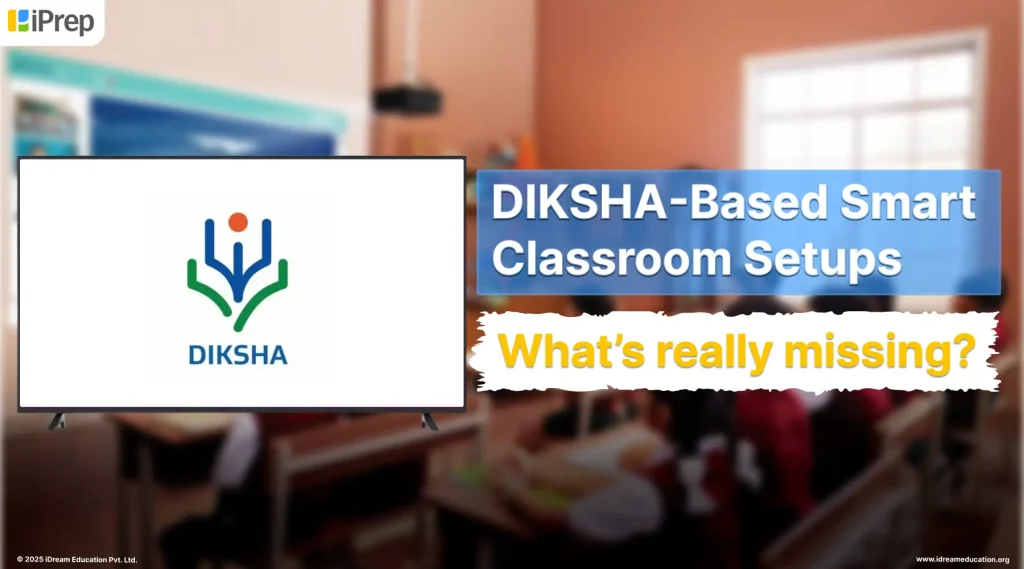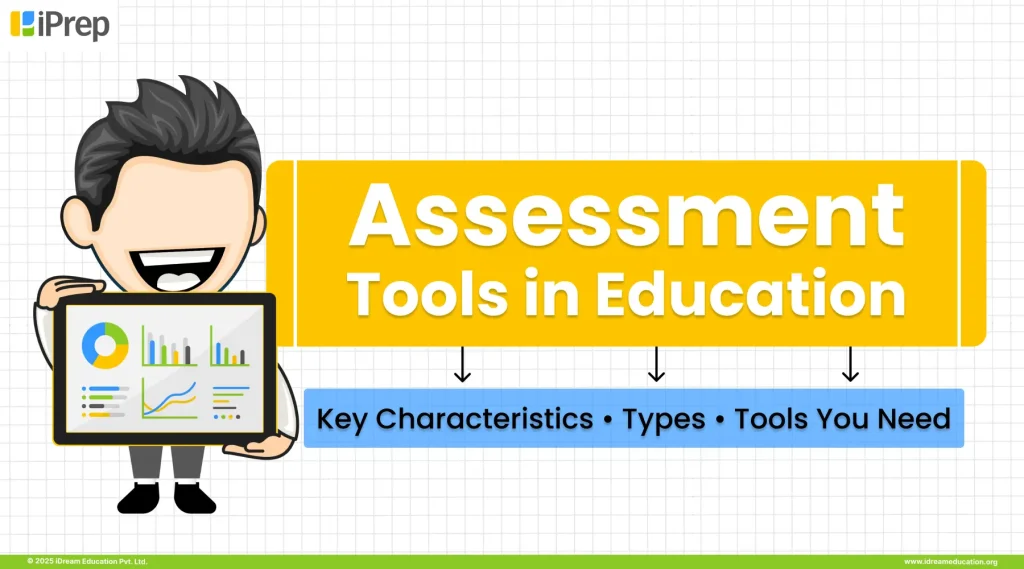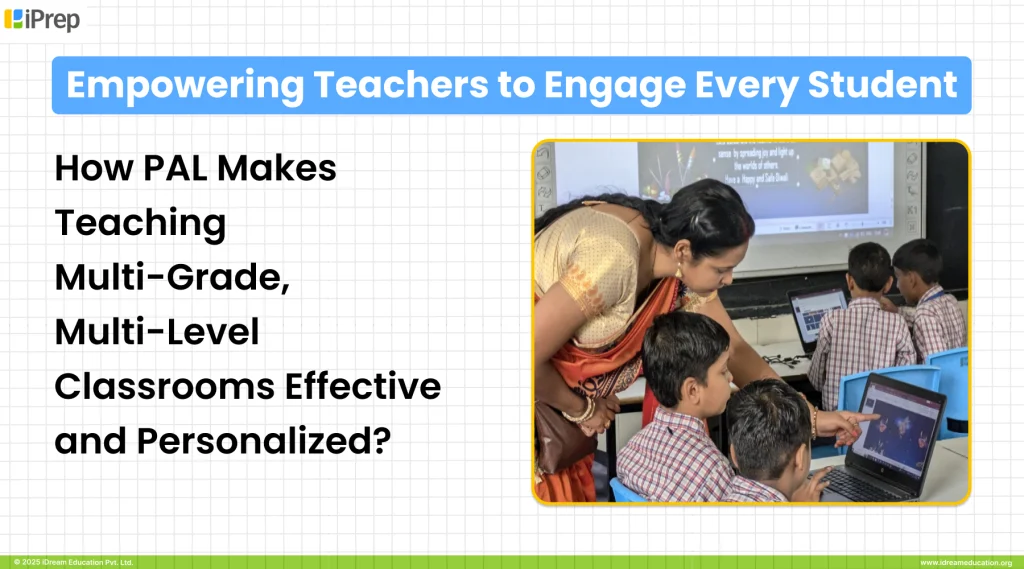Learn how to set up a digital library for schools to enhance access to digital library resources through a bilingual digital library platform.
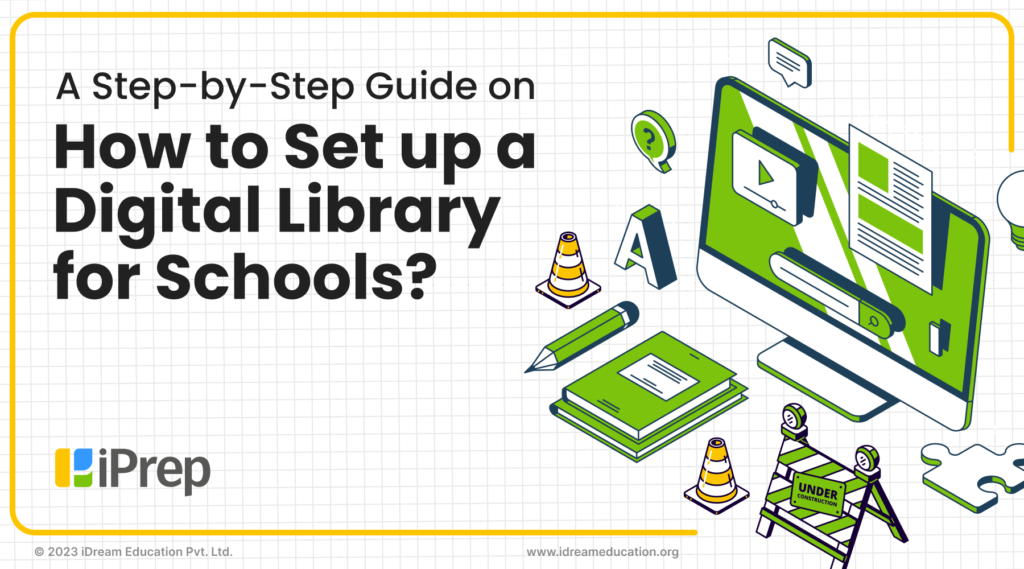
Imagine a library where reading and digital library resources, digital learning content, and every piece of educational content including K-12 books and beyond academics are just a click away. A place where students aren’t limited by the confines of physical shelves, but instead have a universe of information that combines their academic and non-academic learning resources. That’s the power of a digital library for schools, and it’s easy to set up, manage, and even use.
Before we guide you through setting up a digital library for schools, let’s explore a few inspiring examples that have paved the way for digital libraries in India.
- The National Digital Library of India (NDLI), developed by the Indian Institute of Technology Kharagpur with the support of the Ministry of Education, provides a vast collection of educational resources for students of all levels, from primary to postgraduate. With millions of books, articles, videos, and more, NDLI has become a cornerstone of digital education in India.
- Digital Library of India (DLI), is an ambitious government initiative to digitize and preserve India’s vast cultural and intellectual heritage. This monumental project aims to make literary, artistic, and scientific works freely accessible to everyone, everywhere, for educational, research, and cultural purposes. The DLI began with the mission to convert all copyright-free books and manuscripts in India into digital format, ensuring their preservation for future generations and fostering a wider appreciation of India’s rich knowledge traditions.
Inspired by these successful models, we immersed deep into understanding the core principles of digital library concepts to meet the unique needs of school education.
Let us first know why schools need a digital library set up when the internet already offers a wealth of information
While it’s undeniable that the internet is a vast repository of knowledge, it’s not always the most conducive environment for focused learning, especially for school education. Today’s students are increasingly visual learners, and a well-created and curated digital library platform can offer a wealth of engaging multimedia content like curriculum-aligned educational videos, interactive simulations, audiobooks and so much more that cater to diverse learning styles.
- Additionally, the sheer volume of information available online can be overwhelming and time-consuming to navigate. A affordable digital library for schools acts as a trusted guide, curating resources that align with the curriculum and extracurricular interests, ensuring that students can easily find relevant and reliable information without getting lost in the digital maze.
- Beyond that, not every student has equal access to technology or a reliable internet connection, particularly in government schools located in remote areas. A school-based digital library setup levels up the availability of digital learning resources offline, ensuring that every student, regardless of their socioeconomic background, has access to the same high-quality educational resources and personalized learning.
This gives the need for a digital library solution for school education which requires minimal infrastructure to set up and provide well-curated, easily accessible learning resources on a single platform. Crucially, it should be capable of updating information even with limited internet connectivity. This inclusive approach ensures that all students and teachers, regardless of location, internet access, or school infrastructure, have equal opportunity to benefit from the wealth of available knowledge as per state/national educational goals
Let’s take a closer look at how you can set up a Digital Library For Schools
School infrastructure across regions may differ, but the need for quality education remains universal. A digital library solution can bridge this gap, providing equitable access to a curated repository of offline and online learning resources. The solution should align with the broader vision of your education initiative, fostering a love for learning in last-mile learners regardless of location or socioeconomic background. By setting up a digital library for schools, you can enhance teaching and learning experiences, without making any infrastructural changes.
Find out the essential components required to set up a digital library for schools
Infrastructure

Unlike traditional libraries, digital libraries are simple to set up and manage. Our innovative design, modeled after an ICT lab, eliminates the need for dedicated personnel/librarians to manage it. A charging and storage rack can accommodate 5, 10, 20, 30, 40, or more devices like tablets, desktops, Chromebooks, or notebooks. This solution is designed keeping in mind the schools with limited resources or those in remote areas, providing convenient access to digital learning resources to students and teachers. It does not require any additional wiring, furniture, or dedicated space. In this, multiple devices can be charged simultaneously using a single power plug for 3-4 hours and can be used by students during the entire school day. This adaptability makes the digital library an ideal solution for K-12 educational institutions where you can plan to maximize resources and enhance learning opportunities with a single solution.
All-Inclusive Digital Library Platform

The digital library should be one that enhances the learning experience of students through an all-inclusive digital library platform. iPrep is one such platform that seamlessly integrates diverse digital library resources with a reporting dashboard. This empowers teachers, project managers/administrators to track individual student usage, fostering data-driven insights for measurable outcomes. Our Digital library platform provides access to diverse digital library resources including a rich collection of books, engaging video resources, and comprehensive learning materials. It comprises a wide array of categories, including inspirational biographies, life skills, health, safety, sanitation, moral education, and Indian festivals, ensuring a holistic learning experience. Furthermore, the iPrep Digital Library Platform enables access to age-appropriate content, ensuring that students interact with materials tailored to their developmental stage. The digital library resources also include K-12 curriculum-aligned content in various forms such as videos, notes, practice exercises, and syllabus books, to further enhance the educational value of the digital library setup. Teachers in rural and urban areas are looking for ways to balance tech with access. Choosing the best digital library for schools often starts with understanding what works for both learners and classrooms.
Easy User Interface of Digital Library Platform

A seamless user experience is crucial for the successful implementation of a digital library in schools. Our digital library platform iPrep prioritizes intuitive design, adhering to universal design principles to ensure easy navigation and accessibility for all users. To further simplify the setup process, our library platform comes pre-installed on devices with pre-loaded digital library resources, allowing users to dive right in. Recognizing the importance of linguistic diversity, iPrep offers a bilingual interface that adapts to the language chosen for content, supporting languages like English, Hindi, Marathi, Kannada, Odia, and more. This feature not only promotes inclusivity but also makes the digital library platform by the best digital library provider more approachable for users with varying language preferences, encouraging wider adoption and usage.
Digital Library Resources for School Education

Setting up a digital library in every school is essential to bridge the educational divide and democratize access to quality learning resources. By offering books, videos, and curriculum-based learning materials in one place, our digital library platform gives K–12 students a well-rounded and engaging way to learn. As envisioned in the National Education Policy 2020, this approach fosters not only academic excellence but also holistic development. Digital library platforms such as iPrep, designed with this vision in mind, offer a comprehensive repository of academic and non-academic digital library resources, ensuring that learning remains engaging, interactive, and joyful for every student, regardless of their location or background.
Ongoing Reporting

Setting up a digital library or any other digital learning solution requires more than just implementation. To ensure its usage and improvement in learning outcomes, ongoing tracking is crucial. Integrating a digital library platform with offline reporting capabilities on devices allows for comprehensive usage data collection, even in areas with limited connectivity. This data, automatically synced to project dashboards and command centers, provides valuable insights into daily usage patterns and student interests. With this information, teachers, and project officials can make informed decisions, conduct targeted repeat training, and address low usage issues effectively. By prioritizing usage tracking and data-driven strategies, schools can maximize the impact of their digital libraries, fostering better engagement in vast learning resources.
Explore how iDream Education’s multilingual offline digital libraries are enabling anytime, anywhere learning.
Final Thoughts: Choose a Partner, Not Just a Product
Setting up a digital library in schools goes far beyond installing hardware or loading content. It’s about creating a unified, seamless experience for students, teachers, and administrators. That’s why it’s essential to choose a digital library technical partner who is an all-inclusive digital library setup including hardware, digital library platform with rich digital library resources, analytics, and ongoing support.
By partnering with a single, capable technical partner for digital library setup such as iDream Education, you can ensure a hassle-free implementation—right from procurement and setup to training, usage tracking, and long-term maintenance. Our digital library platform is designed to work effortlessly across diverse school environments, be it rural or urban, government or private, with or without internet.
For government bodies, NGOs, and institutions working towards educational equity, the right digital library platform must be easy to use, scalable, and impactful. It should offer engaging, curriculum-aligned content along with offline reporting tools that help track student learning and measure the real-world outcomes of your digital library initiatives.
Make a smart, future-ready choice
Opt for a digital library implementing agency that simplifies management, maximizes impact, and supports you at every step. With iDream Education, you’re not just adopting technology; you’re enabling a lifelong culture of learning. If you are looking for a technical partner for a digital library implementation, contact us at +91 7678265039. You can also write to us at share@idreameducation.org or fill out the query form. We look forward to collaborating with ecosystem partners and setting up a digital library for schools across the nation so that every last-mile learner has access to digital library resources.
Quick Insight on How to SetUp a Digital Library for Schools
- Setting up a digital library for schools is easier than ever with preloaded devices, bilingual content, and minimal infrastructure requirements.
- A well-designed digital library setup includes charging racks, tablets or notebooks, and an all-inclusive platform with curriculum-aligned and library content including books, stories, poems, biographies, exam prep, journals and lot more
- Digital Library platforms such as iPrep Digital Library simplify how to set up a digital library by offering offline access, e-learning content in hindi, english and local language with student usage tracking.
- A school-based digital library is far more effective than open internet browsing, offering focused, safe, and inclusive learning for every student.
- Whether you’re an educator, NGO, foundation, policymaker, or anyone working to improve education, understanding how to set up a digital library can help bring joyful and equitable learning to last-mile learners
Frequently Asked Questions -
1. How to setup a digital library in schools?
Start by choosing a reliable digital library technical partner that offers hardware, digital library platform and resources to ensure digital libraries are easy to set up and manage in any school environment.
2. What are the essential digital library resources for schools?
Key library resources include eBooks, videos, audio stories, curriculum-aligned content, life skills & value education, Ramayana, STEM Coding & Science, Visual Art, Financial & Digital Literacy, Sports, Health, Yoga, Music, and more to support holistic student development.
3. Which digital library platform is best for Indian schools?
Look for a digital library platform of iDream Education that offers K-12 academic and beyond academic content, offline access, reporting tools, and multilingual support.
4. Why is a technical partner important for digital library implementation?
A technical partner is important because they handle everything—from procurement and delivery to setup and ongoing support of digital library hardware and software—ensuring smooth and scalable implementation.
5. Can a digital library work without the internet in schools?
Yes, choose a digital library platform that supports offline access and usage tracking for low-connectivity areas. One such digital library vendor is iDream Education
6. How to choose the right digital library resources for students?
Select content that is age-appropriate, curriculum-aligned, holistic available in multiple languages, and engaging across formats.
7. Who can help set up a complete digital library system in schools?
Organizations such as iDream Education offer end-to-end digital library solutions from procurement to lifetime support.
8. Is digital library setup expensive for government schools?
Not necessarily. Scalable and modular platforms are available that fit budget constraints while offering long-term value.


